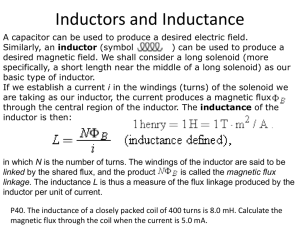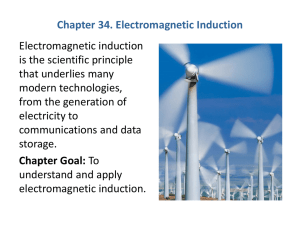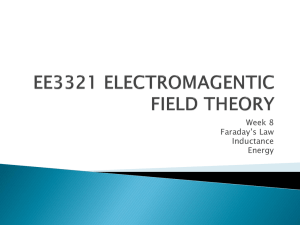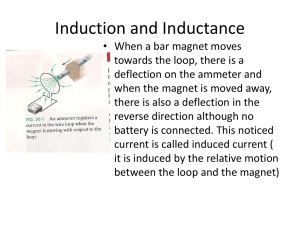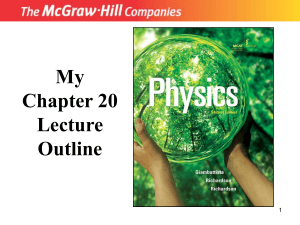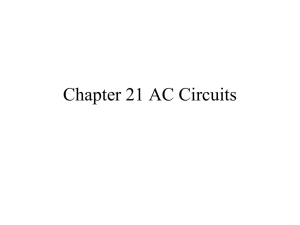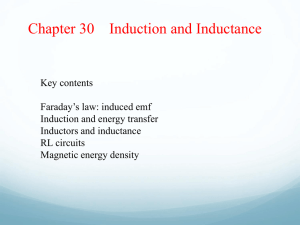E = Blv
advertisement
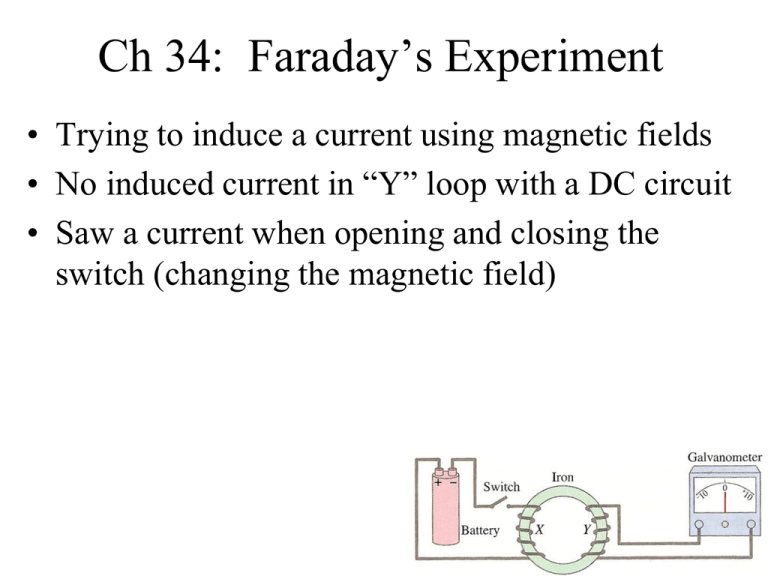
Ch 34: Faraday’s Experiment • Trying to induce a current using magnetic fields • No induced current in “Y” loop with a DC circuit • Saw a current when opening and closing the switch (changing the magnetic field) Electromagnetic Induction Faraday’s Law - An induced emf is produced by a changing magnetic field – Can move magnet or loop – Direction of motion controls direction of current – No movement, no current Predict the direction of the induced current Motional EMF • A current is caused by an electric field • Current continues until FB = FE FE = qE qE = qvB E = vB FB = qvB Which is the correct picture? E = Blv (assumes B ┴ to v) An airplane travels at 1000 km/hr in a region where the earth’s magnetic field is 5 X 10-5T (vertical). Calculate the potential difference between the wing tips if they are 70 m apart. 1000 km/hr = 280 m/s E = Blv E = (5 X 10-5T )(70 m)(280 m/s) = 1.0 V A metal bar of length l rotates in a magnetic field B that is perpendicular to the plane of rotation. It rotates at an angular speed of w. a. Determine the potential difference between the two ends of the bar (HINT: substitute for w, and then integrate from 0 to l, the pivot to the end) Motional EMF • Moving a bar or wire produces charge separation • If looped, produces a current • Bar doesn’t want to move (Lenz’s law), must exert a force • Remember Fmag = IlB Fpull = vl2B2 R l = length R = resistance Example Consider the following set-up. The bar is 10.0 cm long. a. Calculate the current needed for the bulb (P = IV) b. Calculate the resistance of the bulb c. Calculate the speed needed to achieve this current. (E = Blv) d. Calculate the force required for the pull EMF in a Moving Conductor • Slide a conducting bar on the wire loop • Increasing area • What direction is the induced current? (right hand rule) Moving Conductor: Ex 2 Blood contains charged ions. A blood vessel is 2.0 mm in diameter, the magnetic field is 0.080 T, and the blood meter registers a voltage of 0.10 mV. What is the flow velocity of the blood? E = Blv v = E /Bl v = (1.0 X 10-4 V) (0.080 T)(0.0020m) v = 0.63 m/s Magnetic Flux (flow) FB = Magnetic Flux FB = BAcosq B = Magnetic Field (T) A = area passes through (m2) q = Angle ┴ to surface If B ┴ to surface – Cos 0o = 1 – Maximum flux If B || to surface – Cos 90o = 0 – No flux Faraday’s Law of Induction E = -NDFB Dt N = number of loops in a wire DFB/Dt = change in magnetic flux over time So why is it negative? Lenz’s Law An induced current’s magnetic field opposes the original change in flux • Always tries to keep magnetic field inside loop constant. • Use right-hand rule to predict direction of current. – Curve your fingers around the loop – v is direction of the induced current Lenz’s Law: Ex 1 Why is the direction of the current as indicated? • Area is decreasing • Flux is decreasing • Induced current points into paper through ring Lenz’s Law: Ex 2 What will happen to the current if you allow the ring to relax to its original shape? • Larger area • Induced I will reverse direction 3 Ways to cause an emf 1. Change the magnetic field 2. Change area of loop 3. Rotate the loop (or magnet) No flux Maximum flux Lenz’s Law: Ex 3a Predict the direction of the induced current in the following situations • Counterclockwise current • Magnet is going in (north in), need a current pointing north out through the loop • No current • Magnetic flux is || to the loop • Magnetic field decreasing • Counterclockwise current to increase it • Decreasing flux • Clockwise current induced B • Initially no flux • Flux increases to left • Counterclockwise current A long straight wire carries a current I as shown. a. Predict the direction of the magnetic field inside the adjacent loop. b. As the wire is pulled away from the loop, predict the direction of the induced current. Motional EMF E = DFB Dt E = BDA Dt E = BlvDt Dt E = Blv (assumes B ┴ to v) Lenz’s Law: Ex 4 A square coil of 100 loops is quickly pulled from the magnetic field as shown in 0.10 s. Calculate the change in flux. FBfinal =0 FBinitial = BAcos0 FBinitial = (0.60 T)(0.050m)2(1) FBinitial = 0.0015 Wb DF = FBfinal – Fbinitial DF = 0 – 0.0015 Wb = -0.0015 Wb What Voltage and current are produced in the loop (assume resistance = 100 W) E = -NDFB Dt E = -(100)(-0.0015 Wb) = 1.5 V 0.10 s V = IR I = V/R = 1.5 V/100 W = 0.015 A (15 mA) Faraday’s Law of Induction E = -NDFB Dt E = NvlB IR = NvlB I = NvlB R (V = IR) Faraday’s Law: Ex 1 A patient neglects to remove a 6.0 cm copper bracelet (R = 0.010 W) before getting an MRI. The magnetic field changes from 1.00 T to 0.40 T in 1.2 s. Assume the field passes perpendicular to the bracelet. a. Calculate the magnetic flux for both T’s (FB = Bacosq) b. Calculate the voltage through the bracelet based on the change in flux. c. Calculate the current through the bracelet Induced Electric Fields Coulomb vs. non-Coulomb 1. Coulomb Electric field – created by positive and negative charges 2. Non-Coulomb – created by a changing magnetic field Both exert forces on charges (F = qE) Another version of Faraday’s Law Electric Field outside a solenoid A 4.0 cm diameter solenoid is wound with 2000 turns/meter. The current oscillates at 60 Hz and has an amplitude (maximum) of 2.0 A. Here are some equations to help you: B = m0nI I = I0sinwt a. Determine the electric field inside the solenoid. b. Determine the maximum electric field inside the solenoid. Electric Generators (Dynamo) • Generator is the inverse of a motor • AC Generator shown • Rotation through magnetic field induces I • Current flows first one way, then the other • Segments ab and cd are moving conductor • (Side segments have force in wrong direction) E = Blv┴ v┴ = vsinq E = 2NBlvsinq • Can consider angular rotation q = wt v = wr = w(h/2) E = 2NBlvsinq E = 2NBlw(h/2) sin wt E = wNBAsin wt h = length of ad or bc lh = Area Remember w = 2pf f = frequency (Hertz) w (radians/s) • Over 99% of electricity in US produced by generators – – – – Coal/oil/gas plants Wind power Nuclear Water • 60 Hz in US and Canada • 50 Hz in some others Generator: Ex 1 A 60-Hz generator rotates in a 0.15 T magnetic field. If the area of the coil is 0.020 m2, how many loops must it contain for a peak output of 170 V? E = NBAwsin wt assume wt = 90 E = NBAw = E /BAw w = 2pf = 2p(60Hz) = 377 s-1 N = 150 loops Generator: Ex 2 A 60-Hz generator rotates in a 0.010 T magnetic field. If the area of the coil is 2.0 m2, how many loops must it contain for a peak output of 160 V? (21 turns) DC Generator • Split ring commutator • Many windings smooth out the current Alternator • Engine turns the rotor • Magnetic field produced • Current induce in stationary stator coils Microphones • Coil moves in and out of magnetic field with sound • emf induced in the coil • Current is then sent to speakers, recorders, etc.. Tape Heads Recording • Changing current in coil creates magnetic field • Magnetizes the metal on the tape Playback • Changing magnetic field from tape induces current in coil • Digital tape only has 1’s and 0’s Seismograph • Magnet moves and creates current in coil • Current translated into signal for eart’s movement Transformers • Increase or decrease AC voltage • TV – increase voltage for picture tube • Power packs – decrease voltage • Utility poles – decrease voltage for house YEAH!!! MY FAVORITE TOPIC!!!! • Two coils linked by soft iron core • Can be intertwined • Flux from primary induces a current in the secondary (99% efficient) • Vary number of loops to control voltage VS = NS VP NP • Step-up Transformer – Increases voltage • Step-down Transformer – Decreases voltage • POWER can’t increase (can’t get something for nothing) P = VI PP = PS V PI P = V SI s IS = N P IP N S Transformers: Ex 1 A transformer for a radio reduces the voltage from 120 V to 9.0 V. The secondary has 30 turns and the radio draws 400 mA. Calculate the turns in the primary. VS = NS VP NP NP = NSVP = (30)(120V) = 400 turns VS 9V Calculate the current in the primary IS = N P IP N S IP = ISNS = (0.400A)(30) = 0.030 A (30 mA) NP (400) Calculate the power transformed P = IV P = (0.030 A)(120 V) = 3.6 W (can use either primary or secondary) Transformers: Ex 2 An average of 120 kW of power is sent to a small town 10 km from the power plant. The transmission lines for a total resistance of 0.40 W. Calculate the power lost to resistance if the power is transmitted at 240 V vs. 24,000 V. At 240 V P = IV I = P/V = 120,000 W/240 V = 500 A Ploss = I2R Ploss = (500 A)2 (0.40 W) = 100 kW At 24,000 V P = IV I = P/V = 120,000 W/24,000 V = 5 A Ploss = I2R Ploss = (5 A)2 (0.40 W) = 10 W • Transformers only work on ac • dc only produces a secondary voltage when switch is opened or closed Counter EMF • Counter (back) emf – as a motor turns, an emf is induced that opposes the motion (Lenz’s law) • Counter emf is less than the external voltage when under a load • The slower a motor rotates, the less counter emf Counter EMF: Ex 1 The windings of a DC motor have a resistance of 5.0 W. When the motor reaches full speed, the counter emf is 108 V. What is the current when the motor is just starting up, and when it reaches full speed (voltage = 120 V) Just starting up (almost no counter emf) V = IR I = V/R = 120 V/5.0 W = 24 A At full speed (V = 120 V – 108 V = 12 V) I = V/R = 12 V/5.0 W = 2.4 A Current is VERY high at start – Lights may dim when refrigerator starts – Lights dim if on when starting a car Counter EMF: Ex 2 If a blender or drill jams (motor can’t turn), the device may burn out. Why? – No counter emf – Current can be very high – Wires may heat up Self-Inductance: Solenoids • Solenoid (inductor) – coil of wire (choke coil) • L = inductance of the coil (Henry’s) • As current increases in an inductor, an induced emf is created • Induced emf retards the increase of current (like a back emf) • Usually want to avoid inductance – Resistors are wound in two directions to cancel the inductance • Acts as a resistor for alternating current (impedance) • Ex – dc current can burn out a transformer – ac has self-inductance (impedance) that limits the current Inductance of a solenoid L = m0N2A l m0 = 4p X 10-7 T m/A N = number of turns A = cross-sectional area l = length of solenoid Inductance: Ex 1 Calculate the inductance of a solenoid with 100 turns, a length of 5.0 cm, and a cross sectional area of 0.30 cm2. L = m0N2A l L = (4p X 10-7 T m/A)(100)2(3 X 10-5m2) (0.05 m) L = 7.5 X 10-6 H or 7.5 mH Inductance: Ex 2 The same solenoid is now filled with an iron cores (m = 4000 m0). Calculate the inductance L = (4000)(7.5 X 10-6H) L = 0.030 H or 30 mH Inductance: Ex 3 An inductor is made by tightly wrapping 0.300 mm diameter wire around a 4.00 mm diameter cylinder. Calculate the length of cylinder needed to produce an inductance of 10 mH. (5.7 cm) Inductors in Circuits Used to store charge at high voltage (spark plug within a car) A 1.0 A current passes through a 10 mH inductor coil. Calculate the potential difference if the current drops to zero in 5.0 ms. Energy in Inductors (Energy software in a solenoid) A 10 mH inductor is 5.7 cm long and 4.0 mm in diameter. It carries a 100 mA current. a. Calculate the energy stored in the inductor. (5.0 X 10-8 J) b. Calculate the solenoid volume. (7.16 X 10-7 m3) c. Calculate the magnetic field density (U/volume = 0.070 J/m3) d. Calculate the magnetic field strength. (4.2 X 10-4 T) LC Circuits • • • • Oscillating circuit Responds at natural frequency (resonance) Used in cell phones to pick up a signal Dials change in resonance frequency w= 1 LC LC: Ex 1 A 1.00 mH inductor is to be used for an AM radio. Calculate the capacitance needed to pick up a frequency of 902 kHz to listen to Rush Limbaugh. LR Circuits • • • • Electromagnets Radio tuners L is inductance R is resistance of inductor and any other resistance • Inductor smoothes out the voltage drop/increase • Initially very low impedance • Impedance rises with current I = Ioe-t/t t = time constant (time to read 63% of max) t=L R Turning on current – Current rises quickly, then levels off Turning off current – Opposite shape – I = Imax e-t/t LR Circuits: Ex 1 A solenoid has an inductance of 87.5 mH and a resistance of 0.250 W. Find the time constant. a. Calculate the time constant b. Calculate the time needed to reach ½ of the maximum current. (I = Ioe-t/t) t = L/R t = 87.5 X 10-3 H/0.250 W = 0.350 s Rank in order, from smallest to largest, the time constants of the following circuits. a b c The switch in the following circuit has been in position a for a long time (VL = 0). a. Calculate the current initially (100 mA) b. Calculate the current at 5.0 ms after the switch is thrown. (61 mA) c. At what time has the current decayed to 1% of its initial value? (46 ms) DC vs AC • DC = Direct current – Electrons flow constantly – Electrons only flow in one direction (negative to positive) – Batteries provide DC current DC vs AC • AC = Alternating current – – – – Electrons switch directions “Pulsed current” Home electricity More efficient for power transmission over large distances – USA uses 60 Hertz (60 cycles per second), many other countries use 50 Hz DC vs AC DC •Electrons flow constantly •Electrons flow in only one direction •Batteries AC •Electrons flow in short burst •Electrons switch directions (60 times a second) •House current
